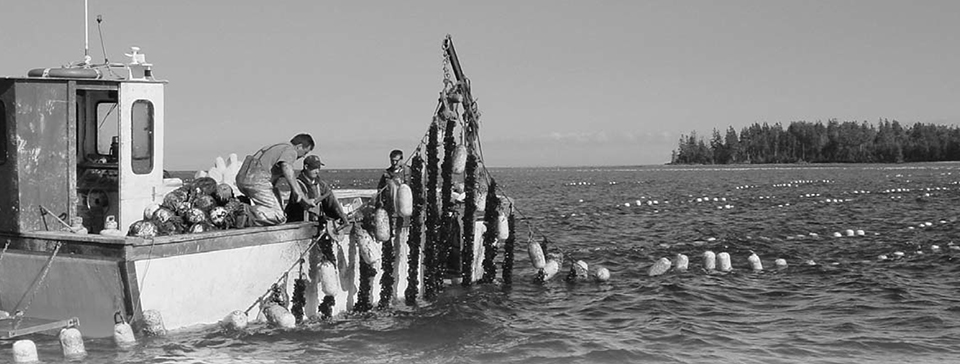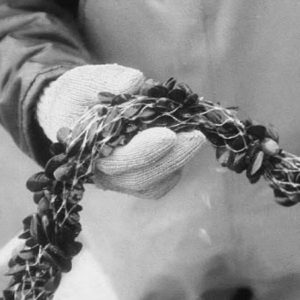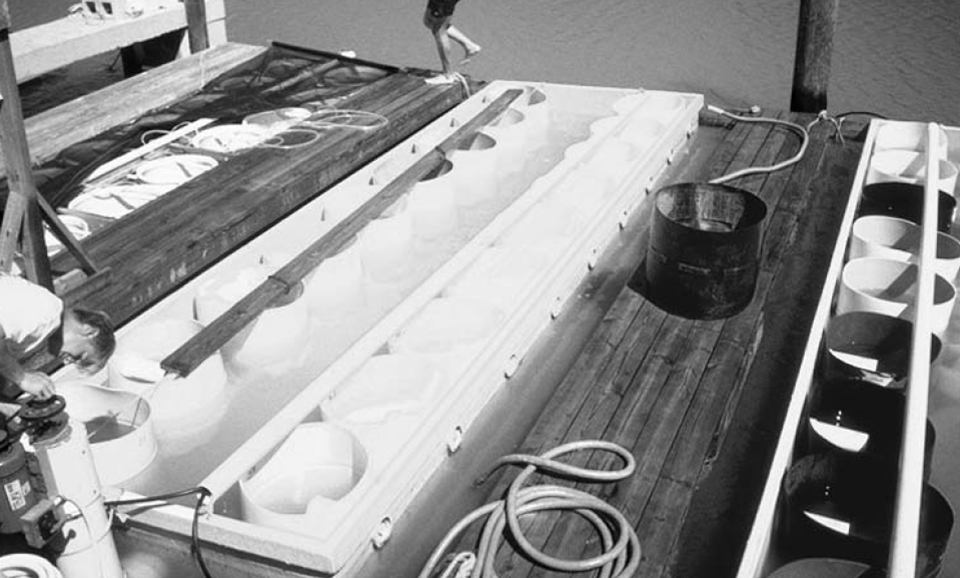Providing more water flow and space than necessary will yield better returns

In the last 20 years, aquaculture – and particularly finfish production – has grown exponentially. Universities have been strong partners in this growth, and faculty can usually make specific recommendations on pond design, feed management, health and disease management, and the handling and transport of fish. It is not always the same situation for shellfish growers.

Many cultured clam and oyster growers lack much of the specific information they need to insure optimum crop growth. Site-specific conditions preclude hard and fast recommendations, and advisors are often at a loss for precise answers to problems. Until many unanswered questions that require extensive research are answered completely, shellfish growers must rely on the basic principles of animal husbandry to make the most of their growing areas and seasons.
From preparing ground and planting seed, to monitoring the environment and ensuring plentiful food, shellfish farmers have to manage their crops wisely if they expect to rear healthy animals and run profitable operations.
Basic conditions
Basic growth parameters must be acknowledged for any organism grown under controlled conditions. Whether the animal is a steer, hog, chicken, clam, oyster, scallop, or mussel, certain conditions support its health and growth and conversely, if ignored, lead to decreased production, disease and eventual mortality.
Sunlight
Shellfish rely on sunlight only as it relates to the photosynthetic process that produces their food. Coupling light with nutrients and carbon dioxide makes the phytoplankton bloom on which the bivalves feed. However, it is also photosynthesis that spurs much of the algal fouling on nursery and grow-out equipment. That is why land-based raceways and upweller tanks are often covered, and field grow-out equipment must be cleaned of fouling macroalgae.
Water
For farm animals, ample potable water is integral to life. It ensures normal metabolic functions and animal health. In shellfish culture, water not only provides those functions, but is also the medium through which food and oxygen are supplied and waste is removed. Shellfish left in small amounts of standing water soon use up the available oxygen and food and die.
Food
Nourishment for any organism is essential. Most shellfish need copious amounts of various algae to survive and grow. From the larval stage to a chowder-sized clam, market oyster or longline mussel, the amount and specific size needed vary, but never cease.
Most shellfish like to feed with a flow of algae going past them. In fact, clams feed better with moving water containing lower concentrations of algae than in stagnant water overpopulated with algal cells. Once shellfish are moved into the field, they grow at the mercy of nature. However, when they are in the hatchery or land-based nursery, it is the culturist’s responsibility to ensure sufficient feed. Supplying a good flow of water is essential to deliver enough algae for greatest growth. Some research indicates that clams grow effectively when they receive water at 5 to 10 times the volume of seed. That means that as seed grow, the water-pumping requirements for the hatchery or nursery operator will increase as the original stocking of shellfish grow.
In an upweller, adequate flow is necessary to insure growth, but the flow of water would be considered too high when the seed bounce off the screen on the bottom of the upweller silo. In a raceway, water dropped in at one end must have enough algae to feed all the shellfish throughout its length. Therefore, raceway length must not be so long that the seed at the end starve. A manageable length is no longer than about 9 meters.

Waste removal
The result of all metabolic processes is waste. Neither farm animals nor shellfish want to live surrounded by their own waste products. Efficient removal through scheduled cleaning of upwellers or raceways with abundant water flow through the system is critical. Rising concentrations of nitrogenous wastes can impact growth and survival of the small seed.
Space and stress reduction
Anyone who commutes on a subway can easily understand the concept of space and stress. Overcrowding and lack of space for extended periods of time ultimately affects any living organism. Chicken farmers know the carrying capacity of their coops, and more importantly, what will happen when that capacity is exceeded. Carrying capacity can be defined as the maximum biomass or quantity of organisms that can be grown in an area without impairing growth rate or survival.
Shellfish growers must not overstock upwellers or raceways. A specific recommendation is hard to make, since every site is different. The density will rely on trial and error over a few seasons. Experimentation with stocking densities, evaluating growth differences at varying rates, will fine tune appropriate volumes.
It is better to understock than overstock. Even in field grow-out, overconcentration of shellfish in bottom plantings, on longlines, in grow-out containers, or even in the estuary itself can lead to slowed production or reduced spawning.
Water temperature
Anyone who has grown shellfish can attest to the impact of low water temperatures on growth and sometimes survival. As water temperature decreases, shellfish reduce their metabolic rates. At low temperatures, they cease growth altogether.
Very small cultured seed should not be forced into outside upwellers on ambient water before the water temperature is appropriate for adequate natural phytoplankton production. Cold water and lack of feed can kill the small crop.
High water temperatures can also cause death. All shellfish have an upper temperature that is lethal to them, and that must be addressed in siting outside upwellers and raceways.
Growers should be very aware when purchasing seed that the temperature tolerance of the source broodstock is similar to natural populations near the grower’s site. In some cases, a species of clam from a warm climate will grow quite nicely in northern climates during the summer, but once winter comes, experience severe mortalities because the seed are not used to cold temperatures.
Disease prevention
Disease prevention is a function of all the other parameters. Sufficient space, adequate food supply, efficient waste removal, and absence of stress will help ensure a healthy crop. Also, operators should store broodstock separately, and if possible, keep different spawns or crops separate as they grow.
Management
The first three letters of the word “management” are key. If the grower ignores his crop, it will go away. More crops have been lost because of too little management than too much. The culturist must care for his “livestock” or there will be none.
Conclusion
Growers in the hatchery, nursery and grow-out phases of shellfish culture should design their specific systems for less-than-perfect years. Sometimes, one year yields great production because everything was just right. The parameters of that year, however, should not be the benchmark against which carrying capacity is based. Providing more water flow and space than necessary is a good management practice that will yield better returns.
When shellfish farmers understand that their crop is much more than just little shells with squishy guts inside, and realize the shells are living organisms with essential requirements for maintaining life and growth, greater success will be theirs.
(Editor’s Note: This article was originally published in the June 2003 print edition of the Global Aquaculture Advocate.)
Now that you've finished reading the article ...
… we hope you’ll consider supporting our mission to document the evolution of the global aquaculture industry and share our vast network of contributors’ expansive knowledge every week.
By becoming a Global Seafood Alliance member, you’re ensuring that all of the pre-competitive work we do through member benefits, resources and events can continue. Individual membership costs just $50 a year. GSA individual and corporate members receive complimentary access to a series of GOAL virtual events beginning in April. Join now.
Not a GSA member? Join us.
Authors
-
Gef Flimlin
Rutgers Cooperative Extension of Ocean County
1623 Whitesville Road
Toms River, New Jersey 08755 USA[117,100,101,46,115,114,101,103,116,117,114,46,112,111,115,101,97,64,110,105,108,109,105,108,102]
-
Jeff Davidson, DVM
Atlantic Veterinary College
University of Prince Edward Island
Charlottetown, PEI, Canada
Tagged With
Related Posts

Intelligence
A model for estimating pathogen variability in shellfish
This study reports on the development of a mathematical model for the shellfish depuration process and its impact on norovirus levels found in shellfish.

Intelligence
An emerging shellfish farming industry in Namibia
For shellfish farming in Namibia to continue expanding, industry must better comply with approved sanitation standards. The Namibian Shellfish Monitoring and Sanitation Program, currently in development, will help.

Responsibility
A look at integrated multi-trophic aquaculture
In integrated multi-trophic aquaculture, farmers combine the cultivation of fed species such as finfish or shrimp with extractive seaweeds, aquatic plants and shellfish and other invertebrates that recapture organic and inorganic particulate nutrients for their growth.

Aquafeeds
A look at phospholipids in aquafeeds
Phospholipids are the major constituents of cell membranes and are vital to the normal function of every cell and organ. The inclusion of phospholipids in aquafeeds ensures increased growth, better survival and stress resistance, and prevention of skeletal deformities of larval and juvenile stages of fish and shellfish species.


